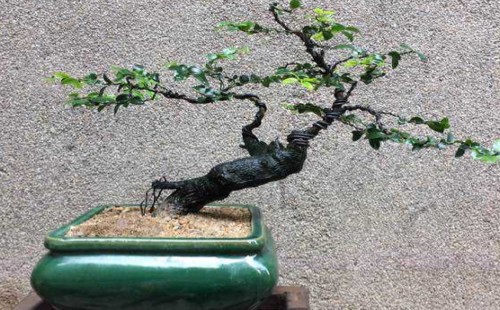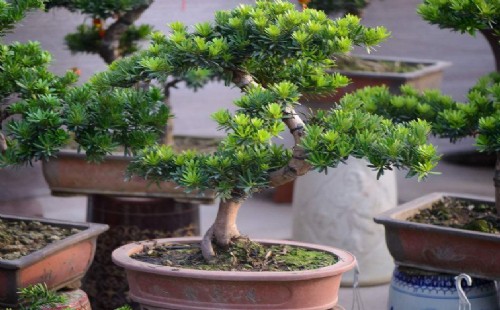Environmental requirements for bonsai growth
Sparrow plum has a strong ability to adapt to the environment, has indomitable vitality and germination, and the tree shape is strange, and because of this, people often make it into bonsai appreciation for this reason. In fact, sparrow plum is indeed a very good bonsai material, which can be seen in many places, especially in the coastal areas of Jiangsu and Zhejiang, which is deeply sought after by bonsai lovers. However, the sparrow plum bonsai has certain requirements for its growth environment, so what are the requirements for the growth environment of Finch plum bonsai?

According to the characteristics of the growth habits of sparrow plum, we know that Finch plum likes the warm and humid climate, and the requirements for basin soil are very low, whether it is acidic soil or neutral soil, or weakly alkaline soil, often can survive. It's just that in different soil environments, its growth is different. It can be seen that Finch plum does not have high requirements for soil quality, and its adaptability is relatively strong. But at the same time, Finch plum is not cold-resistant, with the characteristics of drought resistance, water resistance and barren tolerance. Because of its strong ability to adapt to the environment and strong germination, its root system must be relatively developed.
In general, the environment that affects the normal growth of plants is often composed of light, temperature, humidity, water and fertilizer and other factors. Therefore, as for the requirements of the sparrow plum bonsai on the growth environment, it often becomes the requirement of the climatic environment and soil environment. If the climate environment and potted soil environment are more suitable, it can often ensure that the sparrow plum bonsai can maintain a good growth state. Let's take a look at these factors that make up the growth environment.
I. soil environment
The basin soil environment is the basic condition to ensure the normal growth of plants, while Finch plum has the characteristics of barren tolerance, and the requirement for soil quality is not high, generally providing it with fertile, loose, breathable and slightly acidic soil. The PH value is generally kept in the range of 5. 5-8, and the normal growth can be maintained. For the preparation of basin soil, rotten leaf soil, pond mud, river mud and sand are generally mixed and used according to a certain proportion.
2. Lighting environment
Sparrow plum likes to grow in a semi-shady environment, especially in summer, shading measures should be done to avoid direct sunlight, while the light in spring, autumn and winter is relatively weak, which can provide it with sufficient light. If the sparrow plum bonsai is placed in indoor maintenance, it must be placed in a bright place with sunny and good lighting, so as to avoid the lack of light and normal photosynthesis, resulting in poor growth.
Third, temperature environment
Finch plum itself is native to the tropics, likes a warm growing environment, and it is not cold-resistant, so measures should be taken to keep warm and keep cold in winter. Because when the temperature in the growing environment is as low as 10 °C, the plant will be in a state of stagnant growth, and if the temperature is lower, it is more prone to freezing injury. Especially in the case of low temperatures such as frost, it will affect its safety to survive the winter, so it is necessary to take measures to keep warm and keep warm in advance.
IV. Water and fertilizer environment
Sparrow plum prefer the moist growth environment, although it is also more resistant to barren, but also like the fertile and loose soil environment, so water and fertilizer management should be timely. Spring, summer and autumn are the peak growing season of sparrow plum, and the demand for water and nutrients is relatively large, so the supply of water and fertilizer should be timely, and generally maintain the frequency of water and fertilizer once every 1-4 days to provide the necessary humidity and nutrients.
Time: 2019-05-22 Click:
- Prev

Is the bonsai of black bone tea hardy?
Black bone tea also has a better name, black bone incense, is a four-season evergreen tree species, due to relatively rare wild, artificial breeding difficulties, so once became a rare tree species, the price in the market for a long time high, perhaps in short supply is one of the most important reasons! That's for sure
- Next

Can Luohansong be planted outdoors in Shandong?
As we all know, although Luohansong has high ornamental value, it is not only suitable for landscaping, but also used as a potted plant, but it is also an excellent tree species for making bonsai. However, Luo Hansong prefers warmth and light, so it is very suitable for planting in the south of China, while the temperature in the north is too low in winter.
Related
- Fuxing push coffee new agricultural production and marketing class: lack of small-scale processing plants
- Jujube rice field leisure farm deep ploughing Yilan for five years to create a space for organic food and play
- Nongyu Farm-A trial of organic papaya for brave women with advanced technology
- Four points for attention in the prevention and control of diseases and insect pests of edible fungi
- How to add nutrient solution to Edible Fungi
- Is there any good way to control edible fungus mites?
- Open Inoculation Technology of Edible Fungi
- Is there any clever way to use fertilizer for edible fungus in winter?
- What agents are used to kill the pathogens of edible fungi in the mushroom shed?
- Rapid drying of Edible Fungi

